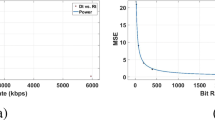Abstract
There are evidences to indicate that a user’s perception is affected by varying frame rate and bit rate with respect to different video content characteristics. We attempt to understand the differences of motion and texture characteristics by adopting both the objective assessment and the subjective assessment methodologies. In this paper, the peak signal-to-noise ratio (PSNR) is used as the objective measurement, while the double stimulus continuous quality scale (DSCQS) is used as the subjective measurement. We find that the low motion characteristic sequences suit to low frame rates while the high motion characteristic sequences suit to high frame rates under the limited bandwidths. The perceived quality of the complex texture characteristic sequences has significant difference at different bit rates. The results indicate that a multimedia scheduling system for transmitting the low motion and smooth texture (Type 1) sequences and the low motion and complex texture (Type 2) sequences should reduce frame rate to increase the bits of frame under the insufficient bandwidth, whereas the high motion and smooth texture (Type 3) sequences and the high motion and complex texture (Type 4) sequences should keep frame rate to decrease the bits of frame. The perceived quality of Type 1 and Type 3 sequences can be improved by increasing bit rate more than Type 2 and Type 4 under the limited bandwidth.
Similar content being viewed by others
References
ISO/IEC JTC1/SC29/WG11: Information Technology—Generic Coding of Audio–Visual Objects: Visual ISO/IEC 14496-2/ Amd X, December (1999)
Li W. (2001). Overview of fine granularity scalability in MPEG-4 video standard. IEEE Trans. Circuits Syst. Video Technol. 11(3): 301–317
Hands D.S. (2004). A basic multimedia quality model. IEEE Trans. Multimed. 6(6): 806–816
Apteker R.T., Fisher J.A., Kisimov V.S. and Neishlos H. (1995). Video acceptability and frame rate. IEEE Multimed. 2(3): 32–40
Yadavalli G., Masry M. and Hemami S.S. (2003). Frame rate preferences in low bit rate video. Int. Conf. Image Process. 1: 441–444
van der Schaar M. and Radha H. (2001). Temporal-SNR rate-control for Fine-Granular Scalability. Int. Conf. Image Process. 2: 1037–1040
Gulliver S.R. and Ghinea G. (2004). Changing frame rate, changing satisfaction? IEEE Int. Conf. Multimed. Expo 1: 177–180
de Cuetos, P., Reisslein, M., Ross, K.W.: Evaluating the streaming of FGS-encoded video with rate-distortion traces. Institut Eurecom Technical Report RR-03-078 June 2003
Aeluri, P.K., Bojan, V., Richie, S., Weeks, A.: Objective quality analysis of MPEG-1, MPEG-2, and Windows Media video. The 6th IEEE Southwest Symposium on Image Analysis and Interpretation, pp. 221–225, 28–30 March (2004)
T1.801.03- 2003: American National Standard for Telecommunications—Digital Transport of One-way Video Signals—Parameters for Objective Performance Assessment. American National Standards Institute. Washington
Pinson, M.H., Wolf, S. A new standardized method for objectively measuring video quality. IEEE Trans. Broadcast. 50(3), 312–322
Yao, S., Lin, W., Lu, Z., Ong, E., Etoh, M. Objective quality assessment for compressed video. ISCAS ’03. In: Proceedings of the 2003 International Symposium on Circuits and Systems Vol. 2, pp. 688–691, 25–28 May (2003)
Rohaly, A.M. et al.: Video quality experts group: current results and future directions. In: Proceedings of SPIE Visual Communications and Image Processing, Vol. 4, Perth, Australia, pp. 742–753, June (2000)
Zink M., Schmitt J. and Steinmetz R. (2005). Layer-encoded video in scalable adaptive streaming. IEEE Trans. Multimed. 7(1): 75–84
Ghinea G. and Thomas J.P. (2005). Quality of perception: user quality of service in multimedia presentations. IEEE Trans. Multimed. 7(4): 786–789
Ito Y. and Tasaka S. (2005). Quantitative assessment of user-level QoS and its mapping. IEEE Trans. Multimed. 7(3): 572–584
Nam J., Ro Y.M., Huh Y. and Kim M. (2005). Visual content adaptation according to user perception characteristics. IEEE Trans. Multimed. 7(3): 435–445
Alpert, Th., Evain, J.-P.: Subjective quality evaluation-The SSCQE and DSCQE methodologies. ITU-R Recommendation BT.500-7, no. 271, pp. 12–20, 1997
ITU-R Recommendation BT.500-11: Methodology for the Subjective Assessment of the Quality of Television Pictures. ITU, Geneva, (2002)
Microsoft: ISO/IEC 14496 MPEG-4 Video Reference Software. Version: Microsoft-FDAM1-2.5- 040207
Hair J., Anderson R., Tatham R. and Black W. (1998). Multivariate Data Analysis, 5th edn. Prentice Hall, Upper Saddle River
Author information
Authors and Affiliations
Corresponding author
Additional information
LihChyun Shu was supported in part by NSC grant NSC 95-2221-E-006-277.
Rights and permissions
About this article
Cite this article
Sun, HM., Lin, YC. & Shu, L. The impact of varying frame rates and bit rates on perceived quality of low/high motion sequences with smooth/complex texture. Multimedia Systems 14, 1–13 (2008). https://doi.org/10.1007/s00530-007-0101-1
Published:
Issue Date:
DOI: https://doi.org/10.1007/s00530-007-0101-1




